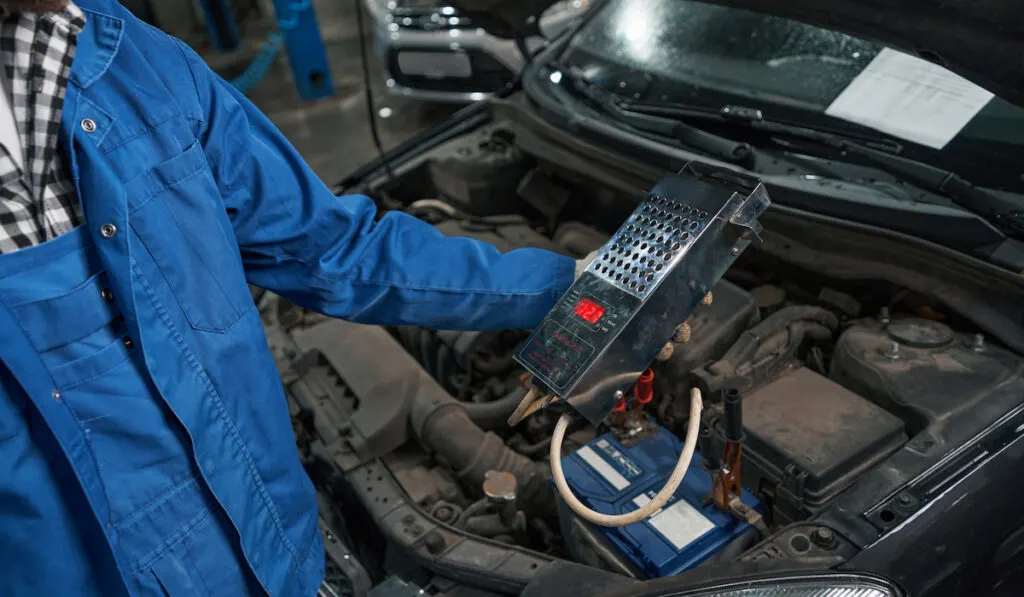*This post may have affiliate links, which means I may receive commissions if you choose to purchase through links I provide (at no extra cost to you). As an Amazon Associate, I earn from qualifying purchases. Please read my disclaimer for additional details.
All types of batteries, deep cycle or not, will ultimately go bad as you use them. Of course, when they do become defective, they lose most of their function or become useless.
Understandably, you will not want to be caught unawares when your battery becomes almost functionless.
Unfortunately, many variables determine the rate of degradation of batteries. So, it is often hard to predict when they will become defective.
You may not be able to foretell when your battery will become faulty. But if you watch closely, you will notice some early signs. In this article, we discuss 3 simple ways to tell if a deep cycle battery is bad.
Table of Contents
1. Examine Your Battery

One way to verify the status of your battery is to do a thorough examination. If done appropriately, a physical inspection should reveal a lot about your battery.
Signs to Look Out For
When examining the battery, look for some of the following signs:
- Significant discoloration
- Broken or loose terminals
- Leaks
- Bulging
- Exterior cracks.
What Some of the Signs Mean
Besides hinting that your battery is losing function, some of the signs above indicate potential danger.
A broken terminal on your battery, for instance, can become dangerous if you continue using the battery. You may end up having a short circuit as a result.
When you have a short circuit, all the power the battery has stored is instantly released. This instant release can damage any equipment connected to your battery. In some instances, the batteries can overheat and explode.
Any bulging on the battery may be a sign of overcharging. Holes, cracks, and splits on the battery may signify degradation. So, once you notice any of these signs, your battery may have become unsafe for use.
For some deep cycle batteries, once they have leaked too much fluid, they will begin to fail. The lack of fluid within the battery exposes the plates to oxygen leading to sulfation.
Sulfation can make your battery fail early. So once you notice dark-colored fluids leaking out of your battery, it means your battery requires a replacement.
After a thorough examination, if you find no external damage, the issue is within the cell. This brings you to the second method: checking if your deep cycle battery has the right amount of voltage.
2. Take a Voltage Reading

If physical examination reveals nothing, try taking the voltage reading of the battery. Through this method, you will verify if the battery still holds sufficient charge.
Before carrying out a voltage check on your battery, ensure it is fully charged. Once the battery is fully charged, leave it to rest for 3-5 hours.
Devices to Use in Checking Your Battery’s Voltage
There are three different devices you can use to check the voltage reading of your battery.
- The first device is a digital multimeter, a simple device that measures a battery’s electrical value.
- The second option is a voltmeter, which measures voltage.
- The third option is also a multimeter, but it is analog. So, people rarely use it.
You should always be aware of your battery’s actual voltage. But if you do not remember, you can always find it on the side of your battery. It is always worth checking the voltage of your battery before you proceed to take a voltage reading.
What the Voltage Readings Mean
- If the voltage reading shows 0 volts, it means your battery has experienced a short circuit and is dead.
- If the voltage does not surpass the 10.5-volt mark, it means your battery requires a replacement.
- If the test shows a reading of 12.4 volts or less, but your charger indicates a fully charged battery, it means it is sulfated and will require replacement.
Charging a sulfated battery is pointless because the battery will not hold any charge. You must replace the battery immediately.
3. Carry Out a Load Test on Your Deep Cycle Battery

You can choose to perform the load test on your own or take the battery to your local automotive shop. Most shops will charge you a small fee to test your battery to determine if you need to replace the battery.
The load test is to ensure your battery can provide power without any fluctuations. When you begin to notice voltage drops, this is a sign that your battery has started failing.
How to Carry Out a Load Test on Your Deep Cycle Battery
- To carry out a load test on your battery, start by removing your battery from its terminals and hooking it up to your load tester.
- Once the battery is connected, use a single load to create a circuit.
- While holding the prongs connected to the cell’s terminals, closely observe the meter’s readings.
- Ensure you do this for at least 30 seconds so you can accurately observe the behavior of the voltage.
What the Results of the Load Test Mean
- If your 12-volt battery is healthy, it should give you a reading of around 9.5-10 volts. But if your test produces a different result, it means there might be a problem with your battery.
- If the test gives you a reading within the specified range but drops gradually, there is something wrong with the battery.
- If the test also gives you an instant zero (0 volts), your battery needs to be replaced.
Resources:
- https://batterymanguide.com/how-to-tell-if-a-deep-cycle-battery-is-bad/
- https://shopsolarkits.com/blogs/learning-center/how-to-tell-if-a-deep-cycle-battery-is-bad
- https://itstillruns.com/deep-cycle-battery-bad-5432771.html
- https://www.greenway-battery.com/news/How-To-Tell-If-A-Deep-Cycle-Battery-Is-Bad–Voltage-And-Maintenance%3F-963.html
- https://www.batterychargerslab.com/how-to-tell-if-a-deep-cycle-battery-is-bad/
